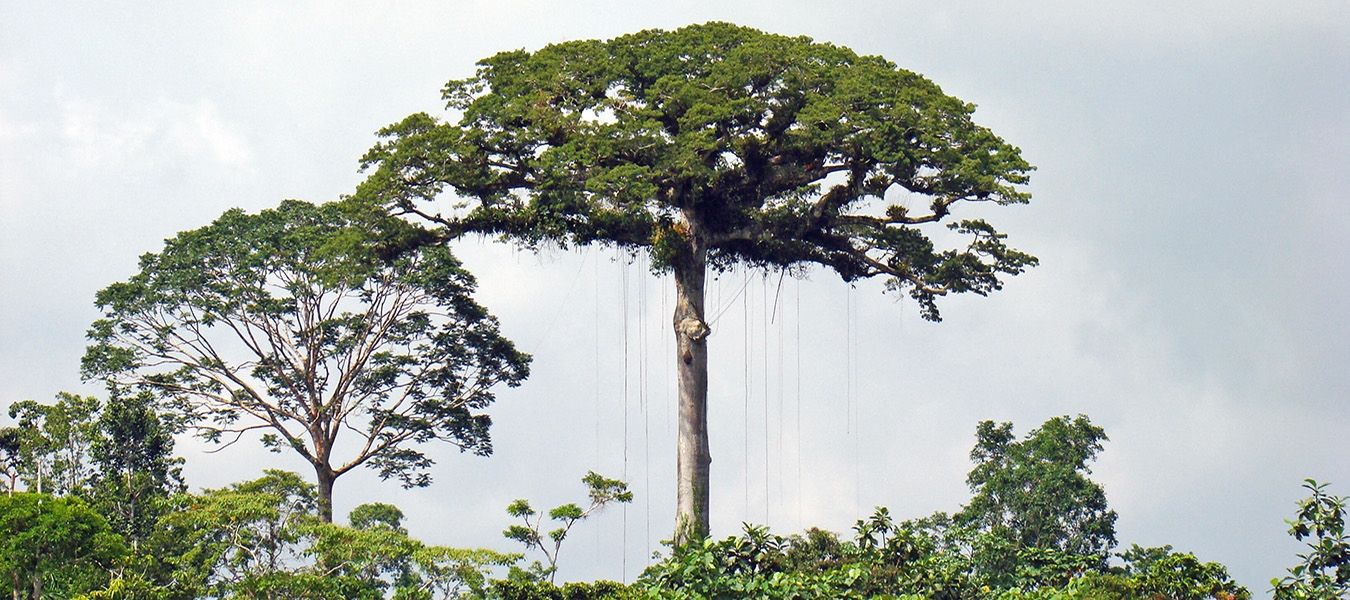
Clouds settle over coastal hills, supplying the dry forest with long-awaited rains, and recharging rivers
Ceiba’s conservation goals in western Ecuador have grown beyond the Lalo Loor reserve, and now encompass protecting and restoring forests up and down this wild and unique coast. We are collaborating with coastal municipalities to enact a “Conservation and Sustainable Use Area” (ACUS, in Spanish), thanks to a federal policy that grants counties the right to directly declare regional reserves. The goal is to create a continuous corridor of forest that incorporates both habitat protection and sustainable economic development in partnership with local communities. Since last year’s Kapok, two of the three counties involved in the initial planning process, Pedernales and San Vicente, ratified the ACUS declaration, constituting some 77% of the original land area. [*editor’s update: on 14 November, the county of Jama also ratified the ACUS!]. A fourth heavily forested county, Sucre, has since joined the effort, expanding the potential forest area under protection to over 250,000 acres.
The agreement will link the Lalo Loor forest to the Mache-Chindul Ecological Reserve, a national park 40 miles north that is dominated by humid rainforests, and reach down to the very dry forests of the Cordillera del Bálsamo community reserve some 45 miles south. The corridor spans the equator, connecting the Northern and Southern hemispheres, and will be the first ACUS in Ecuador to include not just forests but coastal zones as well. These varied ecosystems harbor a diverse array of rare and threatened tropical species, including the critically endangered Ecuadorian White-faced Capuchin monkey, and the Ecuadorian Mantled Howler monkey, and the coastal sites include vital nesting beaches for endangered Green and Olive Ridley sea turtles.
A Conservation and Sustainable Use Area does more than just protect forests and beaches. It also encourages farmers to adopt ecologically-friendly land use practices, like shade coffee and tree plantations. These land uses generate much-needed income for an economically disadvantaged region, but drastically reduce the negative impacts of cattle ranching and industrial farming on the area’s waterways, soil quality, and biodiversity. Farms that combine an understory of coffee with shade trees, for example, can provide excellent habitat for migratory songbirds and local wildlife.
As more counties officially join the Conservation and Sustainable Use Area, Ceiba will harness the contributions of donors to support local conservation and sustainable development projects. Ceiba will offer “Seeds for Sustainability” grants to ease the burden on farmers transitioning to better land uses, and continue our popular reforestation program (see below). Donations also will maintain environmental education programs (see page 4) that have brought hundreds of local people in closer contact to the nature that surrounds them, fostering greater support for habitat protection and establishment of the Coastal Conservation Corridor.
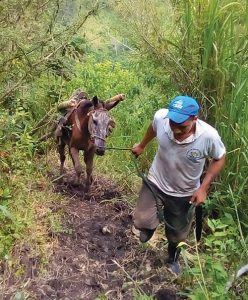 The mules carrying plastic crates full of tree seedlings slipped on the muddy slope as they picked their way up a steep pasture to the reforestation area. “We’ve had to wait a week longer because of all the rain,” said Marcelo Luque, Ceiba’s field coordinator for the Coastal Conservation Corridor, a long-term effort to reconnect the remaining patches of threatened tropical dry forest native to coastal Ecuador. Of the 245 hectares undergoing restoration during the first phase of the project, many are in steep areas that were deforested long ago, where pastures or croplands are unproductive and prone to severe soil erosion. Tree planting has to be done at the start of the rainy season, from November to February, giving plants time to establish before the summer droughts. It is hard physical work, and Ceiba employed a dozen men from nearby rural communities.
The mules carrying plastic crates full of tree seedlings slipped on the muddy slope as they picked their way up a steep pasture to the reforestation area. “We’ve had to wait a week longer because of all the rain,” said Marcelo Luque, Ceiba’s field coordinator for the Coastal Conservation Corridor, a long-term effort to reconnect the remaining patches of threatened tropical dry forest native to coastal Ecuador. Of the 245 hectares undergoing restoration during the first phase of the project, many are in steep areas that were deforested long ago, where pastures or croplands are unproductive and prone to severe soil erosion. Tree planting has to be done at the start of the rainy season, from November to February, giving plants time to establish before the summer droughts. It is hard physical work, and Ceiba employed a dozen men from nearby rural communities.
One of the sad challenges to large-scale reforestation in an area where so much forest has been lost is finding enough seeds from trees in the wild to germinate the huge numbers of seedlings needed. Ceiba’s first step was to contract a local agronomist, Mr. Perfecto Martínez from the village of Tabuga, to collect seeds and establish a giant tree nursery. To reduce the numbers of tree seedlings required, the project also harnessed nature’s own resilience. More than half of the acreage is being restored through “assisted regeneration”: fencing off and preventing fires in the areas to be revitalized, and letting them recuperate naturally. The regrowing vegetation is jump-started by planting a few native trees that might not return to the site on their own; these “focal trees” act as perches for birds flying in from nearby forests, carrying seeds of even more native plants. The eight landowners involved in the first phase were celebrated at the project’s closing ceremony in October, and shared their experiences with others who may get involved in the next phase, if funding is secured. We are grateful to the U.S. Fish and Wildlife Service for a Wildlife Without Borders grant, and the donors to Ceiba’s “Trees by the Ton” campaign, for making this project possible!
New open-air classroom provides students a leafy, and breezy, place to learn
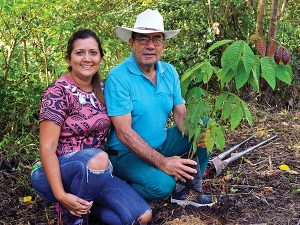 On the heels of celebrating 15 years of conservation at the Lalo Loor Dry Forest reserve (Bosque Seco Lalo Loor, in Spanish), Ceiba is proud to pass the baton to the Loor family in 2020! Thanks to their unflagging trust, the reliable support of our donors, and years of hard work by Ceiba staff, the reserve has achieved financial self-sufficiency, and is a popular destination for ecotourists, school groups, and volunteers from all over the world. Now that we’ve reached that milestone, the transition of management back to the family is underway. Since we began our collaboration with Mr. Loor in 2004, our mutual goal has always been for the reserve to yield a sustainable source of income for his family. This approach is at the heart of Ceiba’s model, pioneered with the El Pahuma Orchid Reserve, of promoting conservation by helping local people turn land protection into an economically viable livelihood.
On the heels of celebrating 15 years of conservation at the Lalo Loor Dry Forest reserve (Bosque Seco Lalo Loor, in Spanish), Ceiba is proud to pass the baton to the Loor family in 2020! Thanks to their unflagging trust, the reliable support of our donors, and years of hard work by Ceiba staff, the reserve has achieved financial self-sufficiency, and is a popular destination for ecotourists, school groups, and volunteers from all over the world. Now that we’ve reached that milestone, the transition of management back to the family is underway. Since we began our collaboration with Mr. Loor in 2004, our mutual goal has always been for the reserve to yield a sustainable source of income for his family. This approach is at the heart of Ceiba’s model, pioneered with the El Pahuma Orchid Reserve, of promoting conservation by helping local people turn land protection into an economically viable livelihood.
The transition marks a turning point for this biodiverse coastal region, with Lalo’s nature reserve providing an example of a sustainable local enterprise to other landowners and communities. Lalo already is recognized as a regional conservation leader, and his success has already inspired one local family to build tourist cabins set in their bird-rich organic coffee farm. Ceiba will remain involved as clients sustaining the Lalo Loor reserve, bringing our annual field courses to study the threatened tropical dry forest, sending volunteers to contribute to ongoing research projects, and inviting groups to hike in the forest, observe wildlife, and relax in the comfortable facilities. To secure the long-term protection of this unique forest, Ceiba will sign a 50-year conservation easement with Mr. Loor, our second such agreement in Ecuador.
Lalo’s daughter, Mariela Loor, began training this past summer to take over as the reserve’s manager. She has a degree in business administration, and grew up surrounded by the forest she now manages. She and the whole Loor family are ready to make the reserve truly their own, with plans to upgrade existing facilities, promote ecotourism, and offer educational programs to nearby schools. Having worked closely with Lalo, his children, and their forest for so long, we feel like a family that is “cutting the apron strings” to watch with pride as the next generation takes over. We wish them buena suerte!
Participants in the Birdwatching Workshop learn to identify some of Ecuador's 1600 species
 When the instructor began to gut a stewing chicken, participants might have wondered whether they had stumbled into a cooking class instead of a workshop on Bird Tourism. But it was all part of a two-day course during which community members from around the reserve learned about avian physiology (inside and out), ecology, and identification, and how to lead birdwatching tours at their own ecotourism sites. Kelly van Gils, the Lalo Loor reserve’s new Education and Volunteer Coordinator, noted participants “gained a different perspective on how conservation can provide them with income, and what specific needs birding tourists have.”
When the instructor began to gut a stewing chicken, participants might have wondered whether they had stumbled into a cooking class instead of a workshop on Bird Tourism. But it was all part of a two-day course during which community members from around the reserve learned about avian physiology (inside and out), ecology, and identification, and how to lead birdwatching tours at their own ecotourism sites. Kelly van Gils, the Lalo Loor reserve’s new Education and Volunteer Coordinator, noted participants “gained a different perspective on how conservation can provide them with income, and what specific needs birding tourists have.”
Ecuador boasts more than 1600 kinds of birds, and many stunning species from coastal forests can be found nowhere else in the country, like the resplendent Pacific Royal Flycatcher with its flaming orange crown. As access and accommodations improve in this region, more tour guides are bringing visitors, binoculars, and revenue to local birdwatching destinations.
In 2019, the reserve hosted educational seminars covering topics from birding to reforestation to sustainable agriculture. Ecuadorian instructors brought practical knowledge from their own reserves or farms, providing peer-to-peer information sharing and networking opportunities. All workshops included hands-on activities: during the Sustainable Agriculture seminar, participants literally got their hands dirty as they made organic fertilizers from leaf mulch, chicken droppings, and other natural ingredients. Ceiba is delighted to sponsor programs that give conservation leaders valuable tools for their future.
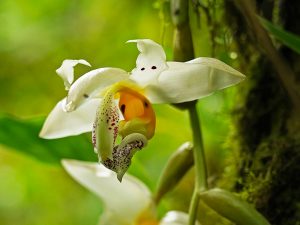 Despite the 2018 declaration of a new Biosphere Reserve encompassing the El Pahuma Orchid Reserve, the threat of mining still looms over the cloud forests of northwestern Ecuador. Although the Ministry of Mining had agreed to cancel all pending concessions in order to win the Biosphere designation, it has backtracked on those promises, and recently signaled it would allow “previously approved” mines to proceed. Devastatingly, one such concession covers a huge portion of El Pahuma. Please join us, and thousands of concerned and motivated citizens in Ecuador, to fight mining on sensitive lands better suited for conservation and ecotourism. Learn more about what you can do to make a difference!
Despite the 2018 declaration of a new Biosphere Reserve encompassing the El Pahuma Orchid Reserve, the threat of mining still looms over the cloud forests of northwestern Ecuador. Although the Ministry of Mining had agreed to cancel all pending concessions in order to win the Biosphere designation, it has backtracked on those promises, and recently signaled it would allow “previously approved” mines to proceed. Devastatingly, one such concession covers a huge portion of El Pahuma. Please join us, and thousands of concerned and motivated citizens in Ecuador, to fight mining on sensitive lands better suited for conservation and ecotourism. Learn more about what you can do to make a difference!
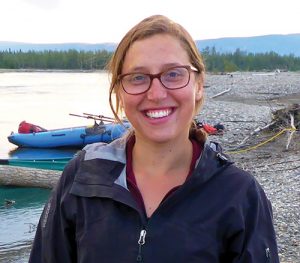 I completed the Tropical Conservation Semester (TCS) with Ceiba in the Spring of 2008 as an undergraduate. TCS was an amazing experience that expanded my language skills, understanding of ecology, and cross-cultural awareness. I will never forget seeing sea turtles while snorkeling in the Galapagos, hiking through clouds at El Pahuma, or swimming in the Tiputini River in the Amazon rainforest. I interned at the Lalo Loor reserve, and the TCS mix of coursework, fieldwork and an internship was a powerful combination. I am now an assistant professor of Geography at the University of Colorado, and I study river systems. The knowledge of both tropical ecology and fieldwork I gained from the TCS has greatly benefitted me throughout my academic career.
I completed the Tropical Conservation Semester (TCS) with Ceiba in the Spring of 2008 as an undergraduate. TCS was an amazing experience that expanded my language skills, understanding of ecology, and cross-cultural awareness. I will never forget seeing sea turtles while snorkeling in the Galapagos, hiking through clouds at El Pahuma, or swimming in the Tiputini River in the Amazon rainforest. I interned at the Lalo Loor reserve, and the TCS mix of coursework, fieldwork and an internship was a powerful combination. I am now an assistant professor of Geography at the University of Colorado, and I study river systems. The knowledge of both tropical ecology and fieldwork I gained from the TCS has greatly benefitted me throughout my academic career.